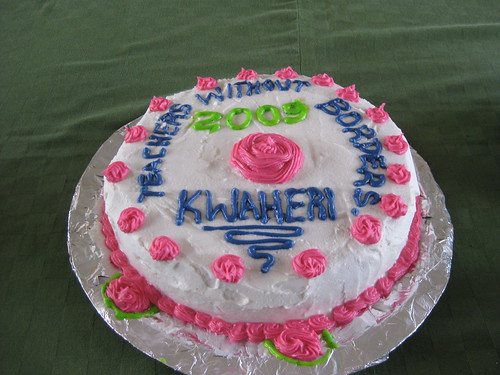 15 August 09
15 August 09
At each of the other sites we’d worked at this summer, the closing ceremony had been a bit of rush. Our team had been organizing certificates, ordering who would speak when and all the other minutia that goes into rallying both pomp and circumstance.
Naivasha was a bit of a different animal.
Because, as I’ve said, this is our second year working with the teachers of Naivasha district, they took over some of the role of organizing. This meant setting up a committee to plan the closing ceremony as well.
We were put to shame.
Not only were their certificates, but they re-organized the room so that lunch was served to us at our seats while speakers reflected on the week’s experiences.
The entire team was called up at one point and individual Kenyan participants presented us each with 5 small hand-carved animals as tokens of thanks.
There was even cake.
And there was praying.
That part was a bit jarring. It highlighted a part of the trip here in Kenya that I’m still digesting. Many of the people we met in our time both in Naivasha and Mbita are quite devout Christians.
Indeed, upon our arrival at Mama Jane’s house in Mbita, the first thing we did was circle the living room, hold hands, bow our heads and offer a prayer of thanks for arriving safely.
This wasn’t too surprising as I’ve known many people to offer similar prayers throughout my life.
It was on our first day of school visits when we were introduced to the teacher or Christian and Religious Studies at one secondary school that I realized religion had a much different place in Kenyan education.
Operating under the mindset not simply of the separation of church and state here in the US, but also of recognizing and respecting a plurality of faiths within our schools, I was surprised by the institutionalization of one faith within Kenya’s public schools.
By the same token, our Kenyan colleagues were taken aback by our apparent lack of faith.
I tried to explain to a few friends that people were not without faith, but that it was more of a private piece of who a person is – an individual choice. That was understandably difficult to communicate when talking with people whose religion has been built into their education.
I didn’t mind it so much until one of the last speakers at the closing ceremony, stood to talk about her faith and the place of God in her life. “Your parents and grandparents put God first,” she said, “but now that is not the case.” She referenced the faith of America’s Founding Fathers and said that it needed to return to our schools.
It was one of those rare moments on the trip when gap between the world of my Kenyan colleagues and my own world was readily apparent.
I didn’t know then (and I don’t know now) how to communicate in a conceptualizable way my belief that it is the plurality of beliefs – religious or otherwise – that makes my classroom and most other American public school classrooms such enriching places to be.
A piece of me says not to worry about it. Another piece of me says that is a bigger conversation to be had over a longer period of time. I’m not sure where the majority of my pieces lie on this one.
I do know it was a closing ceremony that pushed me to think more than all the others.